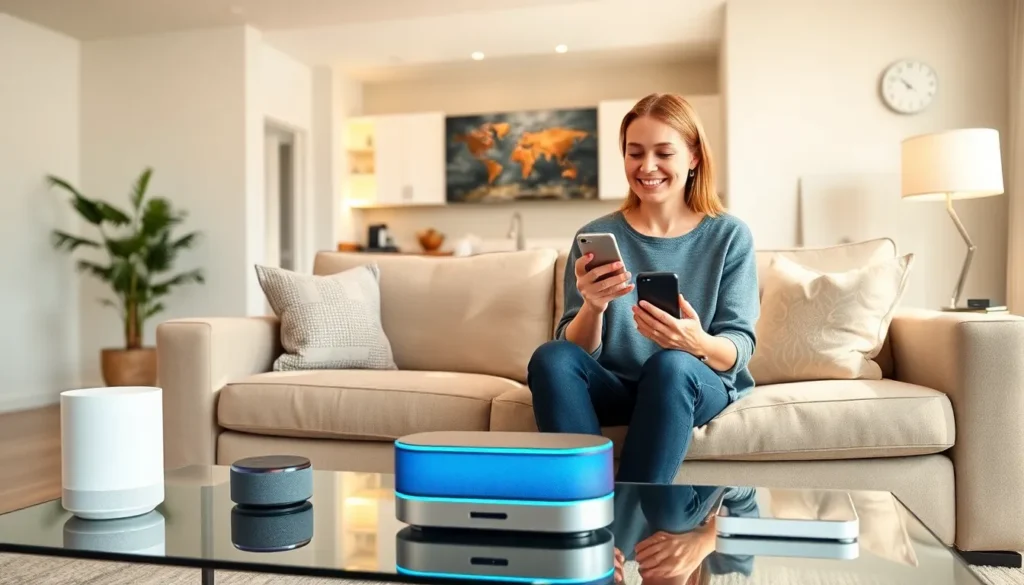Table of Contents
ToggleImagine walking into your home and having it greet you like an old friend. Lights flicker on, the thermostat adjusts to your ideal temperature, and your favorite playlist starts playing—all without lifting a finger. Welcome to the world of smart home integration, where technology transforms everyday living into a seamless experience.
In an age where even your toaster might be smarter than your high school math teacher, it’s time to embrace the convenience and efficiency that smart home devices offer. From voice-activated assistants to automated security systems, integrating these gadgets can make life easier and a bit more fun. Get ready to turn your home into a tech-savvy haven that not only impresses guests but also saves time and energy. Who knew being lazy could feel this rewarding?
Overview of Smart Home Integration
Smart home integration refers to the interconnectedness of various devices that create an automated living environment. This technology uses a centralized system to manage appliances, lights, security, and other functions through a single interface. Users can control multiple devices from their smartphones or tablets, enhancing convenience.
The types of devices involved include smart thermostats, smart locks, and smart lighting systems. Smart thermostats, such as the Nest Learning Thermostat, optimize energy usage by learning user preferences. Smart locks offer keyless entry, allowing access based on user-defined settings. Smart lighting systems enable users to adjust lighting remotely or schedule various scenarios.
Benefits extend beyond convenience. Users experience improved energy efficiency, cost savings, and heightened security. For instance, homes equipped with smart security cameras can monitor activity in real-time, providing peace of mind. Energy-efficient devices reduce utility bills while simultaneously minimizing the environmental impact.
Integration platforms play a vital role in achieving a cohesive smart home experience. Systems like Amazon Alexa, Google Assistant, and Apple HomeKit provide compatibility across various devices. These platforms enable users to create routines that simplify daily tasks, such as turning off lights at bedtime or adjusting the thermostat before arriving home.
Transitioning to a smart home significantly enhances lifestyle. Ease of management empowers users to focus on what matters most while relying on technology for support. As technology advances and more devices become available, the potential for smart home integration continues to expand, making it a strategic consideration for future living.
Benefits of Smart Home Integration

Smart home integration offers various advantages that enhance daily living. Users experience a seamless blend of technology that simplifies their routines and improves their environments.
Enhanced Convenience
Accessing smart home devices from a single app streamlines daily tasks. Control over appliances, lights, and climate with voice commands eliminates the need for manual adjustments. Scheduling routines or automating functions allows for efficiency in household management. For instance, smart thermostats can automatically adjust settings based on user preferences, optimizing comfort levels. Integration facilitates communication between devices; for example, lights can turn on as a door unlocks, ensuring a warm welcome home. Ultimately, users enjoy a smoother, more efficient home environment through these convenient features.
Improved Security
Smart home integration significantly bolsters household security. Automated systems such as smart locks and security cameras provide real-time monitoring and alerts, keeping residents informed of any unusual activity. Homeowners can remotely check camera feeds via their smartphones, adding an extra layer of assurance. With features like video doorbells, users know who arrives at their doorstep without opening the door. Additionally, smart alarm systems can notify users of potential threats, ensuring quick responses. Enhanced security measures through smart technology contribute to peace of mind, allowing families to focus on their daily lives without constant concern.
Key Technologies in Smart Home Integration
Smart home integration relies on several key technologies to enhance convenience and efficiency. Understanding these technologies is crucial for effective implementation.
Internet of Things (IoT)
IoT connects various devices, allowing them to communicate and collaborate. Sensors, smart appliances, and security systems rely on IoT for seamless operation. By employing IoT protocols, users can manage everything from temperature settings to lighting through a single platform. This interconnectedness leads to optimized energy usage and real-time data access. Smart home devices that utilize IoT can analyze patterns, enabling automated adjustments based on user behavior. The integration of IoT results in a responsive home environment, adapting to individual needs effortlessly.
Voice Assistants
Voice assistants serve as central hubs for smart home devices, enhancing user interaction. Amazon Alexa, Google Assistant, and Apple Siri are popular choices for controlling smart technology. These assistants enable voice commands for tasks like adjusting thermostats and turning on lights. Users interact hands-free, providing significant convenience. Setup is often straightforward, allowing for quick addition of compatible devices. Smart home integration becomes intuitive with voice assistants, as they simplify automation and routine execution. Furthermore, they facilitate personalized experiences by learning user preferences over time.
Popular Smart Home Devices
Smart home devices enhance convenience and efficiency in daily living. Several options cater to different needs, featuring technology that simplifies life at home.
Smart Thermostats
Smart thermostats optimize heating and cooling based on user preferences. Devices like the Nest Learning Thermostat automatically adjust temperatures, contributing to energy savings of up to 15%. Users appreciate features like remote access through smartphones, allowing temperature adjustments from anywhere. Advanced models learn behaviors, making adjustments without user input. Integration with virtual assistants further streamlines functionality, offering voice-activated controls.
Smart Security Systems
Smart security systems enhance home safety through advanced technology. Devices like Ring security cameras provide real-time monitoring and instant alerts. Users benefit from features like motion detection and two-way audio, promoting proactive security measures. Professional monitoring services often accompany these systems, ensuring rapid responses during emergencies. Homeowners appreciate integration with smartphone apps, allowing them to manage security settings remotely and maintain peace of mind.
Challenges in Smart Home Integration
Smart home integration presents several challenges that users must navigate. Addressing these obstacles is crucial for maximizing the benefits of a connected home environment.
Compatibility Issues
Compatibility issues commonly arise as smart devices from different brands often lack interoperability. Manufacturers produce proprietary systems, leading to limited device integration. Many users find it frustrating to have devices that cannot communicate with one another. Smart hubs and platforms, like Amazon Alexa or Google Assistant, attempt to bridge these gaps, yet not all gadgets seamlessly connect. Differing communication protocols amplify these challenges, complicating user experience and hindering automation. Updates and firmware inconsistencies can further contribute to compatibility problems. Users often resort to troubleshooting to resolve these conflicts, consuming valuable time that could otherwise enhance the enjoyment of their smart home technology.
Privacy Concerns
Privacy concerns significantly impact smart home integration as connected devices collect personal data. Many smart appliances gather information regarding user habits and preferences, raising potential security risks. Users hesitate to utilize smart technology when they fear unauthorized access to their data. Strong encryption methods can alleviate these worries, but not all devices prioritize user security. Regular software updates also play a key role in safeguarding personal information. Users should understand the privacy policies of connected devices to ensure data protection. Establishing strong passwords and using two-factor authentication offers additional layers of security, allowing homeowners to enjoy smart home advantages without compromising their privacy.
Smart home integration represents a significant shift in how people interact with their living spaces. By embracing this technology, homeowners can enjoy enhanced convenience and improved security while optimizing energy usage. The interconnectedness of devices allows for seamless control and automation, making daily tasks more manageable.
While challenges like compatibility and privacy concerns exist, they can often be addressed with careful planning and awareness. As technology continues to evolve, the potential for smart home solutions to enrich lives is immense. With the right systems in place, individuals can transform their homes into responsive environments that support their lifestyles and priorities.




